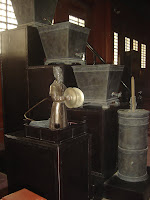
To the north of the Forbidden City in Beijing the prominent building known as The Drum Tower can be seen.
The drums inside this building and the bells inside the nearby Bell Tower regulated the day in the Imperial City.
Anyone fit enough for the climb up the steep flight of many steps that rise inside the drum tower can see giant drums which are replicas of those of ancient times. These are regularly beaten for the benefit of visitors. In the silence of the past the sound would have carried for many miles.
However, the drummers needed to know when to beat their drums and that is where an ingenious water clock came in.
The flowing of water between four different containers allowed time to be measured accurately enough for the purposes of the past.
A replica of the water clock can be seen today. This is referred to as a “Clepsydra,” although the term can’t be found in the Oxford English Dictionary.
There are four bronze water containers. The upper one is known as the Sky Pond, the second as Calm Water, the third as Myriad Parting and the fourth as Water Collecting.
The passage of each quarter of an hour was marked by a small statue of a man with cymbals. A flow of water into the mechanics beneath the figure caused it to clash the symbols together eight times every 15 minutes.
A record of longer periods of time was kept by means of wooden indicators which floated on the water of the lowest tank. Supported by two dragons, the wooden slats were marked with time periods. A store of slats, presumably so that different time periods could be measured, was kept at the side.
The drummers always knew, thanks to the ingenious water clock, when it was time to beat the big drums.
The word "clepsydra" is used to describe a water clock from the Western Han Dynasty (206BC to AD8) which was exhibited in 1998 in Hong Kong at the "Heavenly Creations, Gems of Ancient Chinese Inventions" exhibition This was excavated from a tomb at Mancheng, Hebei in 1968. It is a simple single vertical cylinder with a handled lid at the top and a water outlet at the bottom. The exhibition catalogue explains: "A clepsyrda is an ancient time-measuring device which works by the flow of water. Such water clocks, called "dripping vessels" (louhou) were one type of time-measuring instruments used in ancient China. This particular type came with an indicator called "sinking arrow" (chenjian),inserted through a hole in the handle and the cover. As the water in the vessel dripped through the hole in the bottom, the water level fell and the indicator rod, which was fitted to the float, sank accordingly. The outflow was so adjusted that the marker took a specific time to sink. From graduations on the sinking indicator it was possible to tell the time."
The same exhibition also displayed another clepsydra, from the Yuan Dynasty, cast in 1316. This is similar to the water clock in the drum tower, with four water vessels. The exhibition catalogue states: "Ancient water clocks came in different designs: some consisted of a single vessel, others had multiple vessels. This is the earliest extant example of a multiple vessel design. The four vessels were placed on descending steps of a stepped platform. Water flowed from the sun vessel into the moon vessel, then into the star vessel, finally reaching the water vessel. As the water level rose in the bottom tank, the wooden indicator rose with it, giving a reading of the hour."
***
©www.pbbitsandpieces.com 2009
No comments:
Post a Comment